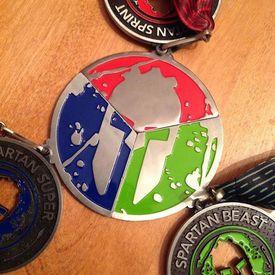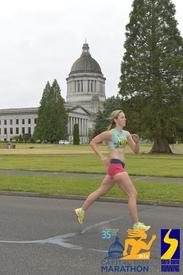1/4 Marathon training

disturbed_s
Posts: 40 Member
So I've decided that I would like to set a goal of entering a 1/4 marathon next year (oct). I realise this is a long way away but if I want to run the whole way when and how would I start to do train? I currently have 'fast walked' this distance a few times, the first time it took 105mins, 2nd 97 mins and today 89 mins this was with bursts of jogging. Am I on the right track? Just keep trying to speed up my times and running bursts? I would like to complete it in an hour if possible. Any tips appreciated thanks 
0
Replies
-
Woops bad English!0
-
1/4 marathon is just over a 10K so a 10K training program should work. To get your legs used to the distance, keep accumulating the miles in your legs. Add in some speed work with interval training and hills to build leg strength.0
-
I'm not familiar with 1/4 marathon as a race distance, presumably the distance is 10km?
In any case....the sooner you start preparing for it, even if you're not following a formal training plan initially, the more enjoyable the experience will be.
If you want to run the whole distance your first goal will be to work on running endurance, don't worry about speed just yet. Feel free to use a run/walk (check out the "Galloway" method") system to get going. Run, at a comfortable pace. for a couple of minutes, take a walk break then repeat. Over time your running intervals should get longer (remember endurance before speed) until you can comfortably run (even at a slow pace) the whole distance.
Building endurance requires consistency, you should be running 3 or 4 times per week (alternating days works well and allows for adequate recovery) with some cross training in between too (strength training is really good for runners as is biking etc). Don't try to overdo it, most running injuries are a result of too much, too soon too fast....0 -
Try the app, Couch to 10K "C210K". It's free and gives you a very manageable program to increase your running endurance! I started with C25K, then 10K, and ran my first half marathon in October
 0
0 -
There are several Couch to 5K programs out there for beginning runners. I'd suggest you do a Google search and find one that fits you. Brian is right on the money and that's how these programs are usually set up. Once you've conquered the 5K distance you can start slowly increasing your running mileage each week until you're ready for a 10K race. There are even programs out there for just that purpose.
The biggest things to remember are:
1. Start slowly. You shouldn't be running any faster than a pace at which you can hold a conversation. The point isn't to go fast at first, it's to build up endurance.
2. Only run every other day and don't do high impact activities on the days between. Your body needs a chance to rest and recover. Running is tough on our joints, especially, and the whole point of building up slowly is to "toughen them up" over time.
3. Avoid the sidewalk, don't run on concrete. Asphalt is better, dirt or grass better still.
4. If something hurts, back off. Unless you have a pre-existing injury, running shouldn't cause pain beyond mild muscle aches. That includes feet, shins, knees, hips, etc. If you're following #2 and #3 and still having problems, it's probably time for #5.
5. Once your mileage starts to increase, you'll want to get fitted for good running shoes. For me, that was around the 3 mile mark and the trigger was black toenails and a niggling pain in my right knee. You want to go to a store that is dedicated to running where they can watch you run on a treadmill and look at your arches, etc. to find you the proper pair of shoes. Good shoes made all of the difference to me.
6. Have fun!0 -
Thanks all, very helpful information! Will re read it all when I get a chance to sit down for a few mins0
-
disturbed_s wrote: »Woops bad English!

Read this discussion:
http://community.myfitnesspal.com/en/discussion/1217573/so-you-want-to-start-running0 -
5. Once your mileage starts to increase, you'll want to get fitted for good running shoes. For me, that was around the 3 mile mark and the trigger was black toenails and a niggling pain in my right knee. You want to go to a store that is dedicated to running where they can watch you run on a treadmill and look at your arches, etc. to find you the proper pair of shoes. Good shoes made all of the difference to me.
Or avoid the risk of injury and black toe nails by getting fitted for shoes straight away.
No one should have black toe nails at only a 3 mile run and that niggling pain might already be something serious.
Seriously. Don't wait until you're in pain to get the correct shoes. That's like waiting until you get hit on the head before wearing a safety helmet at a construction site.
0 -
There are several Couch to 5K programs out there for beginning runners. I'd suggest you do a Google search and find one that fits you. Brian is right on the money and that's how these programs are usually set up. Once you've conquered the 5K distance you can start slowly increasing your running mileage each week until you're ready for a 10K race. There are even programs out there for just that purpose.
The biggest things to remember are:
1. Start slowly. You shouldn't be running any faster than a pace at which you can hold a conversation. The point isn't to go fast at first, it's to build up endurance.
2. Only run every other day and don't do high impact activities on the days between. Your body needs a chance to rest and recover. Running is tough on our joints, especially, and the whole point of building up slowly is to "toughen them up" over time.
3. Avoid the sidewalk, don't run on concrete. Asphalt is better, dirt or grass better still.
4. If something hurts, back off. Unless you have a pre-existing injury, running shouldn't cause pain beyond mild muscle aches. That includes feet, shins, knees, hips, etc. If you're following #2 and #3 and still having problems, it's probably time for #5.
5. Once your mileage starts to increase, you'll want to get fitted for good running shoes. For me, that was around the 3 mile mark and the trigger was black toenails and a niggling pain in my right knee. You want to go to a store that is dedicated to running where they can watch you run on a treadmill and look at your arches, etc. to find you the proper pair of shoes. Good shoes made all of the difference to me.
6. Have fun!
Why shouldn't she run on concrete?0 -
Harder on the joints.0
-
5. Once your mileage starts to increase, you'll want to get fitted for good running shoes. For me, that was around the 3 mile mark and the trigger was black toenails and a niggling pain in my right knee.
oh yes. Waiting until you hurt yourself before getting decent shoes. That's a fantastic idea. I'll also wait until I put my car in the ditch before fixing my brakes.
0 -
A 10k training plan should take about 5 months. Plenty of time.
And as for shoes, I'd agree with leaving those for the first four weeks. It'll take you that length of time to learn your gait, and the run intervals aren't that long in that time.0 -
I've run almost 700 miles over time on concrete. Where's the information that it's any harder than asphalt?Shawshankcan wrote: »Harder on the joints.
0 -
I've run almost 700 miles over time on concrete. Where's the information that it's any harder than asphalt?Shawshankcan wrote: »Harder on the joints.
any engineer can tell you that concrete is harder than asphalt.
If you are fine running on concrete, go right ahead. For someone who is new to running, it is not the ideal surface to start on. It is indeed harder on the body. Running is hard on the body until you get used to it. So, for most people, in makes good sense to get your body used to running before doing a lot of it on concrete. I can run a HM on asphalt and my knees don't feel like I've taken a beating. But 5 km on concrete and I don't want to run again for a week. It truly does make a difference for a lot of runners.
0 -
AllonsYtotheTardis wrote: »any engineer can tell you that concrete is harder than asphalt.
Whilst technically correct, in real terms the effect of that difference is negligible. The main contributors to impact force are mass, pace and gait.
Mammal CEng0 -
I will be doing the majority of running on a treadmill, for the first while at least. I'm assuming there is a big difference between treadmill and outside so will prob venture outside after I'm used to actually running for that distance for a while.0
-
Who ever said waiting until your mileage increases to get fitted for shoes is 100% wrong. This is step #1 (well, before you take your first step!).
The other main point is to get the notion of wanting to speed up out of your head. Your goal is to complete - not compete - at your first distance event. You want to be able to run the entire distance and get a baseline for future races, not be sidelined with an overuse injury because you are giving 110% every time you run. Keep your pace conversational, and slowly build up the miles. And get fitted for shoes first.
Did I mention getting fitted for shoes?0 -
AllonsYtotheTardis wrote: »
I've run almost 700 miles over time on concrete. Where's the information that it's any harder than asphalt?Shawshankcan wrote: »Harder on the joints.
any engineer can tell you that concrete is harder than asphalt.
If you are fine running on concrete, go right ahead. For someone who is new to running, it is not the ideal surface to start on. It is indeed harder on the body. Running is hard on the body until you get used to it. So, for most people, in makes good sense to get your body used to running before doing a lot of it on concrete. I can run a HM on asphalt and my knees don't feel like I've taken a beating. But 5 km on concrete and I don't want to run again for a week. It truly does make a difference for a lot of runners.
Yeah I get that the substance itself is technically harder than asphalt. With the idea of damaging the body in significant amounts, where is the information that it's severe enough to avoid the sidewalk?0 -
A few folks have pointed you to both couch to 5k plans, and 10k plans, which both worked for me. A 10k plan should work fine for "half of the half" races as the distances are pretty close (6.2 vs. 6.55 miles).
My big mistake when starting out was pushing myself too hard. One other purchase that might make sense once you are a few weeks in (after new shoes) would be an inexpensive heart rate monitor. Either bluetooth straps (used with your phone), or watches (timex makes some inexpensive ones) can be had for about $35. I'll usually train at about 70% of my max heart rate which means that even though I've raced middle distances at a 7-8 minute/mile pace, I'll do most of my training at an 11 minute mile pace.
It'll be frustrating at first not going all out every time, but it'll help you avoid injuries and help you build up to the endurance needed for the six and a half miles.0 -
disturbed_s wrote: »I will be doing the majority of running on a treadmill, for the first while at least. I'm assuming there is a big difference between treadmill and outside so will prob venture outside after I'm used to actually running for that distance for a while.
Your assumption is correct in many ways. For me personally, I would rather do just about anything than run any appreciable distance on a dreadmill. In fact, if not for the awesomeness of trail running, I likely wouldn't bother running at all.
TL;DR - try several different surfaces/environments to see which you prefer.0 -
0
-
disturbed_s wrote: »I will be doing the majority of running on a treadmill, for the first while at least. I'm assuming there is a big difference between treadmill and outside so will prob venture outside after I'm used to actually running for that distance for a while.
Don't give up on "real world" running too soon.
It's not a foregone conclusion that treadmills are less injury-genic than the real world is. Running in the real world you get more variation and use of accessory and stabilizing muscles.
Incidentally, there is also some evidence that "green space" experience enhances the positive mental health benefits of exercise. I find this especially true in the Winter when the tendency is to get too cooped up - best time to go run on a trail or in a park.
0 -
I know you said you want to run the whole way, but I'm a big believer in the 10 and 1 plan. For my longer runs I run 10 min and walk one. You may still be building up to this, but even when you have increased your mileage and endurance, the 10 and 1 plan works well. Mentally, when you are tired, you only have to worry about finishing that 10 min block. The 1 min rest really energizes you to go again0
-
disturbed_s wrote: »I will be doing the majority of running on a treadmill, for the first while at least. I'm assuming there is a big difference between treadmill and outside so will prob venture outside after I'm used to actually running for that distance for a while.
Incidentally, there is also some evidence that "green space" experience enhances the positive mental health benefits of exercise. I find this especially true in the Winter when the tendency is to get too cooped up - best time to go run on a trail or in a park.
I agree! There is nothing like running outside. I live in central canada, it gets really cold, but I'd still rather layer up and run outside!0 -
AllonsYtotheTardis wrote: »
I've run almost 700 miles over time on concrete. Where's the information that it's any harder than asphalt?Shawshankcan wrote: »Harder on the joints.
any engineer can tell you that concrete is harder than asphalt.
If you are fine running on concrete, go right ahead. For someone who is new to running, it is not the ideal surface to start on. It is indeed harder on the body. Running is hard on the body until you get used to it. So, for most people, in makes good sense to get your body used to running before doing a lot of it on concrete. I can run a HM on asphalt and my knees don't feel like I've taken a beating. But 5 km on concrete and I don't want to run again for a week. It truly does make a difference for a lot of runners.
Yeah I get that the substance itself is technically harder than asphalt. With the idea of damaging the body in significant amounts, where is the information that it's severe enough to avoid the sidewalk?
The reason why the sidewalk sucks is due to uneven/settled joints, cracks, and the erratic nature of where it joins the street/drives. Plus, you have to yield to folks walking it, as it is not designed to be an athletic activity path like a multi-use path you'd find in a park. As far as impact goes, it's all in peoples' heads.0 -
www.jimgalloway.com
0 -
0
-
0
-
Just want to chime in here... I think the biggest obstacle to running distance is a mental one. Pay attention to the thoughts you're telling yourself. Do you say things like "wow this is hard!" or "I don't think I can do this" OR do you/can you start thinking "I've got this" and "I am strong." It might sound silly, but sometimes if I'm out for a particularly long run, I'll speak aloud to myself something encouraging.
I sincerely believe that a belief that you can is the #1 thing that separates long distance runners from people that never give it a try.
Decide now that you can and will do this. The training plans and specifics will follow from there.
Good luck!
PS this is coming from someone who used to hate running a mile in HS who's completed many 10ks, a few half marathons, and 3 full-distance marathons. 0
0
This discussion has been closed.
Categories
- All Categories
- 1.4M Health, Wellness and Goals
- 398.1K Introduce Yourself
- 44.7K Getting Started
- 261K Health and Weight Loss
- 176.4K Food and Nutrition
- 47.7K Recipes
- 233K Fitness and Exercise
- 462 Sleep, Mindfulness and Overall Wellness
- 6.5K Goal: Maintaining Weight
- 8.7K Goal: Gaining Weight and Body Building
- 153.5K Motivation and Support
- 8.4K Challenges
- 1.4K Debate Club
- 96.5K Chit-Chat
- 2.6K Fun and Games
- 4.8K MyFitnessPal Information
- 18 News and Announcements
- 21 MyFitnessPal Academy
- 1.5K Feature Suggestions and Ideas
- 3.2K MyFitnessPal Tech Support Questions

















